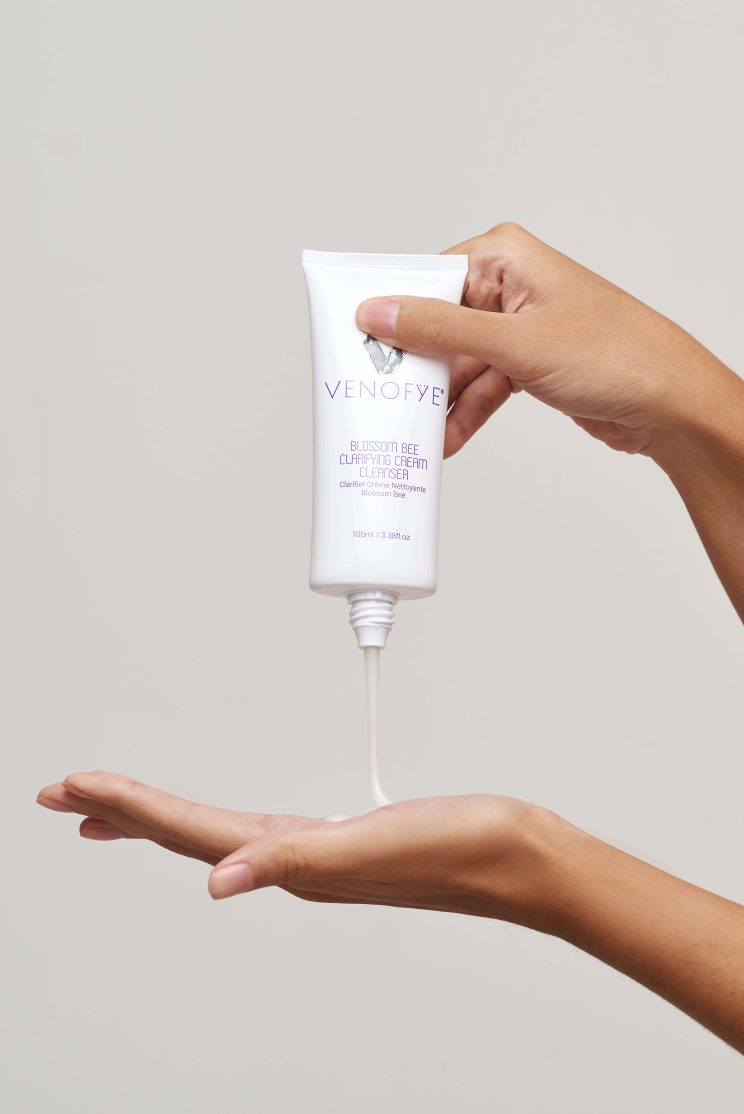Many would agree that cleansing is one of the most important steps of any skincare routine, helping to set your skin up for success when it comes to the rest of the products you apply.
While there’s no arguing with how crucial cleansing is, there’s also no getting away from the fact that using the wrong cleanser can do more harm than good for your skin. This is why it’s essential to make the right choice and pick a cleanser that perfectly caters to your skin’s unique needs.
How do you go about choosing the perfect cleanser for your skin? Read on as Venofye shares the ultimate guide to help you out:
Why Do You Need to Use a Face Cleanser?
If you’re new to skincare, you may be wondering why you need a dedicated face cleanser in the first place. Couldn’t you just use some regular soap and save yourself some money?
Technically, yes. A bar of soap will help to clean your face. However, let’s not forget that the skin on the face is much thinner and more delicate than the skin elsewhere on the body. It’s highly prone to damage, which is often caused by using overly harsh ingredients. Sadly, standard soap products tend to be full of these.
Skipping your facial cleanse isn’t an option either. Even if your skin may feel clean, it most likely isn’t. Between dirt, sebum, pollution, dead skin cells, and all of the other grime that your skin is constantly picking up, the surface of your skin will be covered with a layer of impurities that will prevent your other skincare products from penetrating into your skin cells. Not only will this affect the efficacy of your skincare routine but those impurities can also cause free radical damage. This accelerates the skin aging process.
Now that you understand why it’s so important to have a dedicated face cleanser, let’s take a closer look at how to go about choosing the right one…
Start With Your Skin Type
The most crucial aspect to keep in mind when choosing any skincare product is your skin type. However, when it comes to a face cleanser, this becomes even more important. Use a cleanser that isn’t suitable for your skin type and you’ll end up making your existing skin concerns so much worse very quickly. You’ll likely also end up dealing with new skin problems.
If you aren’t sure what your skin type is, there’s an easy way to find out…
Start by cleansing your skin with the cleanser that you’re currently using. Ideally, it should be a gentle formula. Then, wait for 30 minutes before taking a close look at your skin to see which of the following skin types it most resembles:
Oily Skin
If your skin looks shiny and feels greasy, this means that your skin type is oily. Since your skin is producing so much excess sebum, you’ll need a relatively powerful cleanser to clear all of that extra oil away. With that said, you don’t want to go overboard with a formula that will completely dry out your skin. If you remove every last trace of oil, this will only stimulate your skin to increase its overall sebum production.
Dry Skin
The opposite of oily skin, dry skin will look and feel dry, tight, and uncomfortable when left bare after cleansing. Since this skin type doesn’t produce enough sebum, you’ll need a cleanser that will remove dirt and other impurities without stripping your skin of the precious little sebum it currently has. That sebum serves to lubricate and condition the skin, which dry skin desperately needs!
Combination Skin
If some parts of your face are dry but others are oily, this means that your skin type is combination. One option would be to invest in two cleansers. Use a formula for dry skin on your dry areas and one for oily skin on your oily areas. Alternatively, you could also look for a gentle cleanser that’s suitable for dry skin but spend more time focusing on your oily areas while cleansing.
Sensitive Skin
If your skin looks red and inflamed while feeling irritated, uncomfortable, and maybe also itchy, this means that you have sensitive skin. This also means that your skin barrier has been compromised in some way. As a result, you need to make sure that the cleanser you choose isn’t going to exacerbate this. You’ll need an ultra-gentle formula that will clean your skin without further irritating your skin’s natural protective barrier.
Normal Skin
If your skin doesn’t feel too oily or too dry and there aren’t any obvious areas of inflammation or sensitivities, this means that your skin type is normal. This is the easiest skin type to work with since your skin is already well-balanced. You need a cleanser that’s just as balanced – a formula that will clean your skin without drying it out, and also without interfering with the harmonious sebum production that you currently have going on!
Understand Ingredients
Now that you know more about the cleanser that your skin type needs, it’s time to make sure that you understand the different ingredients that are used in face cleansers. After all, this is the only way to ensure that you pick a product that’s truly compatible with your skin type.
Here are some key ingredients to know about:
Sulfates
Let’s start with sulfates – a group of surfactants commonly found in face cleansers. While they may be popular among skincare brands because of how efficiently they cleanse the skin, they’re ingredients that are best avoided.
Why? Because sulfates are notorious for how they inhibit barrier function and dry out the skin. They remove too much oil from the skin, which is particularly detrimental for those with dry or sensitive skin. However, they don’t do oily skin any favors either, with sulfates known for clogging pores and triggering inflammation and breakouts.
The good news is that sulfates are easily avoidable. Although there are several types of them around, all of these ingredients will have the word ‘sulfate’ somewhere in their names. Scan the ingredient list of any cleanser you’re considering and you should be able to spot them quickly!
Coconut-Derived Surfactants
So, if you shouldn’t be using sulfates, which surfactants should you opt for instead? One safe alternative is coconut-derived surfactants, such as sodium cocoyl isethionate, which you’ll find in Venofye cleansing products.
These surfactants are loved for how they’re naturally derived, as well as biodegradable. Plus, they create a luscious lather without disrupting skin barrier function. In fact, since they contain fatty acids from coconut oil, they can actually leave the skin barrier feeling stronger and more resilient.
Hydroxy Acids
Hydroxy acids are most commonly used as exfoliants, yet they’re often found in cleansers too. Is this a good thing? That depends…
If you have oily skin, a cleanser infused with salicylic acid, which is a beta-hydroxy acid, can be helpful. The acid will enable the cleanser to delve deeper into your pores, allowing for a more thorough cleanse. With beta-hydroxy acids being oil-soluble, they’ll quickly eliminate excess oil.
For other skin types, however, acid-infused cleansers will usually prove to be too much for your skin when used regularly. You may end up dealing with the symptoms of over-cleansing/over-exfoliation.
Antioxidants and Plant Extracts/Oils
When it comes to useful additional ingredients that are incorporated into cleansers, it doesn’t get much better than antioxidants and plant extracts/oils, the latter of which are packed with antioxidants too.
These compounds do so much for the skin. Not only do they help to fight the appearance of free radical damage but they also encourage an overall healthier complexion.
Plant oils take this further, providing hydrating and moisturizing properties too. This is why you’ll find several plant extracts, oils, and additional antioxidants in the Venofye face cleanser.
Explore the Different Cleanser Types
Now that you know what your skin type needs, as well as what key cleansing ingredients do, let’s explore some of the different types of cleansers out there:
Cream Cleansers

Cream cleansers are great for dry and sensitive skin types. They’re usually quite thick and have a creamy consistency that enables them to cleanse the skin without stripping away too much sebum.
The Venofye Blossom Bee Clarifying Cream Cleanser is a fantastic one to try. With its coconut-derived surfactants, a boatload of antioxidants, and an infusion of moisturizing plant oils, it will leave your skin looking beautifully soft and radiant.
Foaming Cleansers
Foaming cleansers are best suited to those with oily or combination skin types. However, keep our above tips in mind when shopping for a foaming cleanser, as many contain sulfates. Fortunately, there are now more and more sulfate-free options out there to choose from.
Clay Cleansers
Clay cleansers work in a similar way to clay masks, in that clay is used to draw out excess sebum from the skin. As a result, they’re best suited to those with oily or combination skin.
Micellar Water
Another good option for those with dry or sensitive skin, micellar water is known for being very gentle. With that said, many of the formulas out there contain common irritants, so keep a close eye on those ingredient lists.
Cleansing Sponges and Cloths
Cleansing sponges and cloths are usually made from special fibers that allow them to be used without the need for an additional cleansing product. They can be a good option for cleansing oily and combination skin but are often too much for dry or sensitive skin. Either way, make sure that you thoroughly cleanse your sponge/cloth after use!
Summary
Hopefully, our guide will now make it much easier for you to choose the perfect face cleanser for your skin. When shopping for options, prioritize your skin type, assess ingredient lists, and consider the different cleanser types too. Bring all of this together and you’ll end up with a cleanser that will remove dirt and other impurities while leaving your skin with a gorgeous glow!
Click here to boost your skincare routine with more bestselling Venofye skincare products.




0 comments on “The Ultimate Guide to Choosing a Face Cleanser”